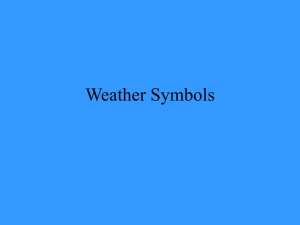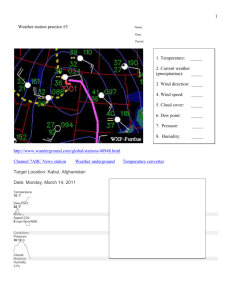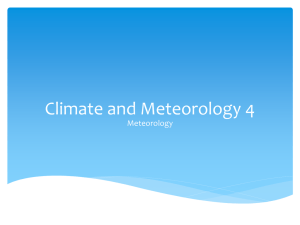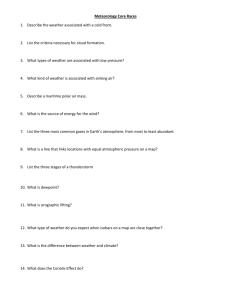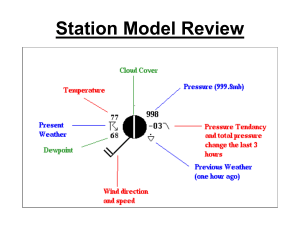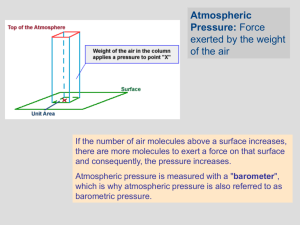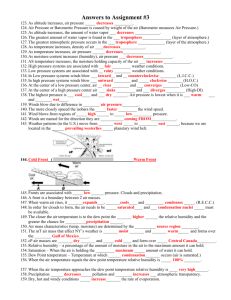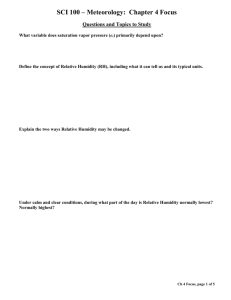Interpreting Surface Observation Symbols
advertisement
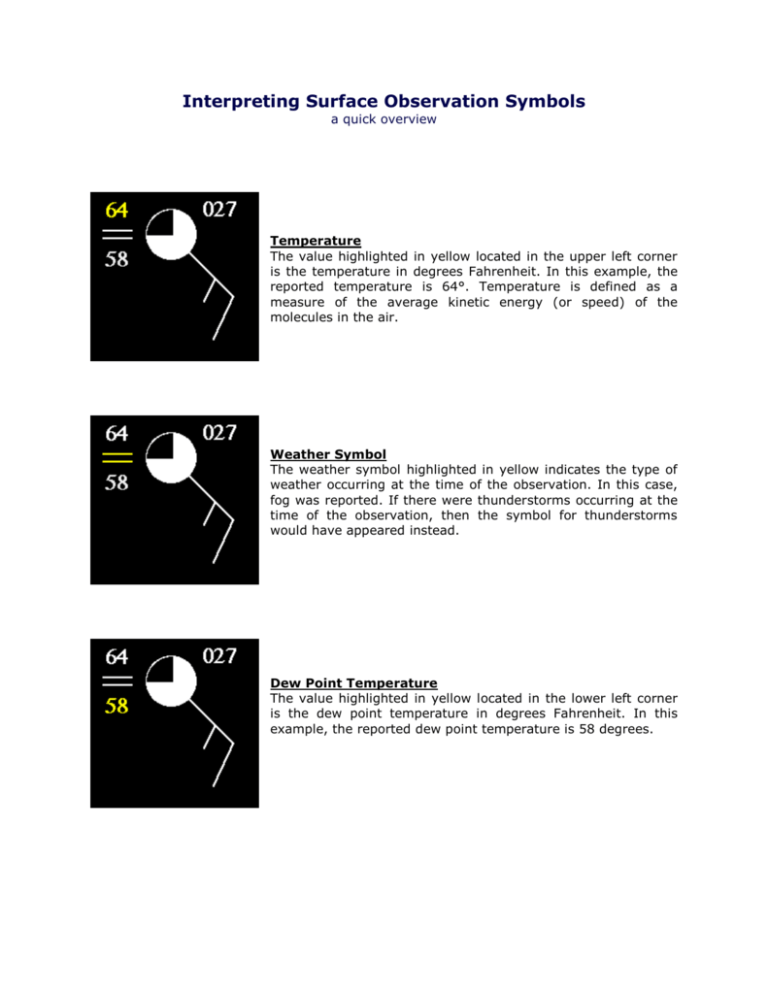
Interpreting Surface Observation Symbols a quick overview Temperature The value highlighted in yellow located in the upper left corner is the temperature in degrees Fahrenheit. In this example, the reported temperature is 64°. Temperature is defined as a measure of the average kinetic energy (or speed) of the molecules in the air. Weather Symbol The weather symbol highlighted in yellow indicates the type of weather occurring at the time of the observation. In this case, fog was reported. If there were thunderstorms occurring at the time of the observation, then the symbol for thunderstorms would have appeared instead. Dew Point Temperature The value highlighted in yellow located in the lower left corner is the dew point temperature in degrees Fahrenheit. In this example, the reported dew point temperature is 58 degrees. Cloud Cover The symbol highlighted in yellow indicates the amount of cloud cover observed at the time of the observation. In this case, broken clouds were reported. Sea Level Pressure The value highlighted in yellow located in the upper right corner represents the last three digits of the sea level pressure reading in millibars (mb). Wind Barb The symbol highlighted in yellow is known as a wind barb. The wind barb indicates wind direction and wind speed. Plotted Station (surface analysis) CH High Cloud type CM Middle Cloud type CL Low Cloud type N Cloud Cover (portion of the sky covered) PPP Atmospheric pressure. The pressure is in millibars but only the last three digits are shown. For example, record a pressure of 1002.1 as 021 and a pressure of 1021.1 as 211. PP Indicate the pressure change since the last observation (in millibars). a Graphical representation of the pressure change ww Present Weather when the observation is taken w Past Weather in the past hour at the time of the observation VV Visibility Code TdTd TT Dew Point Temperature Air Temperature Example Overcast, with an air temperature of 24 degrees Celsius, dew point of 21 degrees Celsius. The wind was from the north-east between 10 and 14 knots. The pressure was 1003.8 millibars decreasing (\) of 1.1 millibars in the last 3 hours (1 1 on the chart). Rain showers with low clouds which were Stratus, the visibility was reduced to less than one kilometer. In the preceding hour of the observation, fog was the weather. Common Weather Symbols Observed Dew Point Temperature Dew points indicate the amount moisture in the air. The higher the dew points, the higher the moisture content of the air at a given temperature. Dew point temperature is defined as the temperature to which the air would have to cool (at constant pressure and constant water vapor content) in order to reach saturation. A state of saturation exists when the air is holding the maximum amount of water vapor possible at the existing temperature and pressure. When the dew point temperature and air temperature are equal, the air is said to be saturated. Dew point temperature is NEVER GREATER than the air temperature. Therefore, if the air cools, moisture must be removed from the air. This is accomplished through condensation. This process results in the formation of tiny water droplets that can lead to the development of fog, frost, clouds or even precipitation. Relative Humidity can be inferred from dew point values. When air temperature and dew point temperatures are very close, the air has a high relative humidity. The opposite is true - a large difference between air and dew point temperatures indicates air with a lower relative humidity. Locations with high relative humidity indicate that the air is nearly saturated with moisture. Clouds and precipitation are therefore quite possible. Weather conditions at locations with high dew point temperatures (65 or greater) are likely to be uncomfortably humid. Cloud Cover Sea Level Pressure Interpreting Pressure Reports: If the reported value is greater than 500, the initial 9 is missing. Place it on the left and divide by 10. For example: 827 = 982.7 millibars. If the reported value is less than 500, the initial 10 is missing. Place it on left and then divide by 10. For example: 027 = 1002.7 millibars. Atmospheric Pressure - force exerted by the weight of the air Atmospheric pressure is the force per unit area exerted against a surface by the weight of the air above that surface. In the diagram below, the pressure at point X increases as the weight of the air above it increases. The same is true about decreasing pressure … the pressure at point X decreases if the weight of the air above it also decreases. Thinking in terms of air molecules, if the number of air molecules above a surface increases, there are more molecules to exert a force on that surface and, consequently, the pressure increases. The opposite is also true … a reduction in the number of air molecules above a surface will result in a decrease in pressure. Atmospheric pressure is measured with an instrument called a barometer, which is why atmospheric pressure is also referred to as barometric pressure. Wind Direction Wind barbs point in the direction from which the wind is blowing. In the case of the example below, the orientation of the wind barb indicates winds from the northeast. The term easterly means that the winds are from the east. In the example above, the winds are out of the northeast, or northeasterly. The term eastward means that the winds are blowing towards the east. Speed Wind speed is given here in knots (knt). A knot is a nautical mile per hour. 1 Knot = 1.15 Miles per Hour (MPH) 1 Knot = 1.9 Kilometers per Hour (KM/HR) A short barb represents 5 knots. A long barb represents 10 knots. Pennants represent 50 knots. Add multiple barbs & pennants together for the total wind speed. If only a station circle is plotted, the winds are calm.
